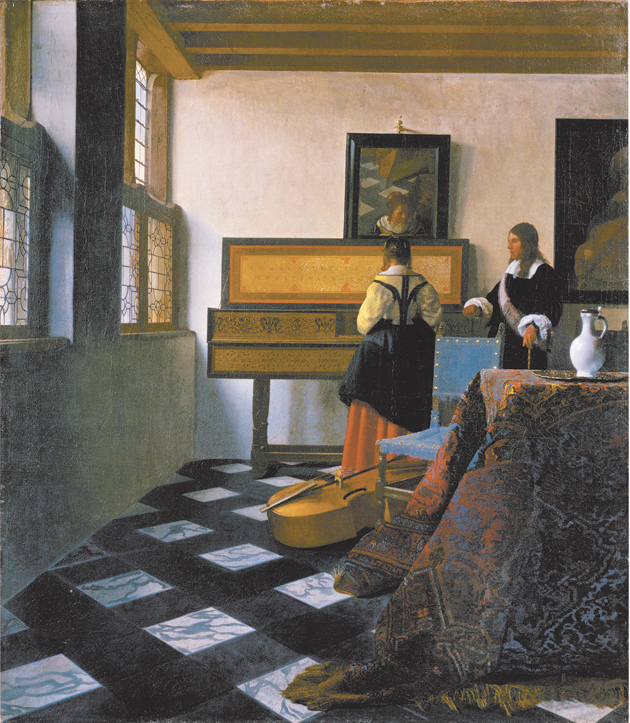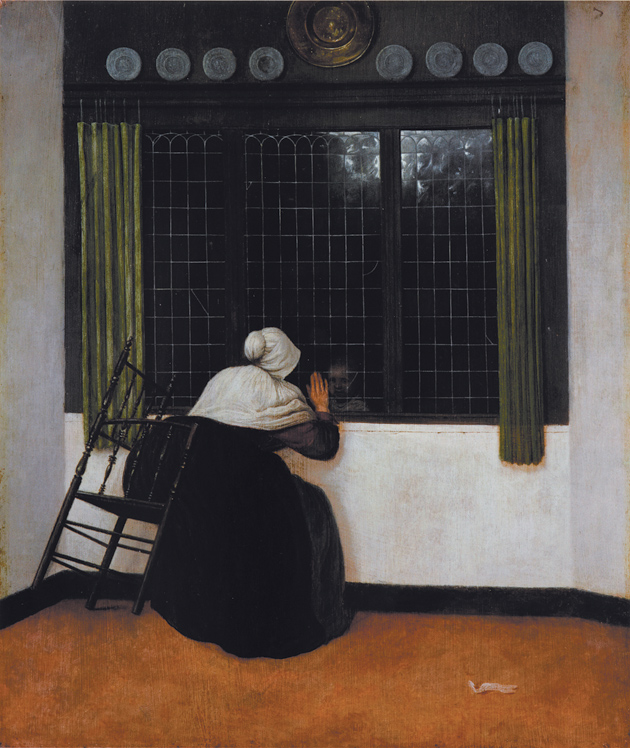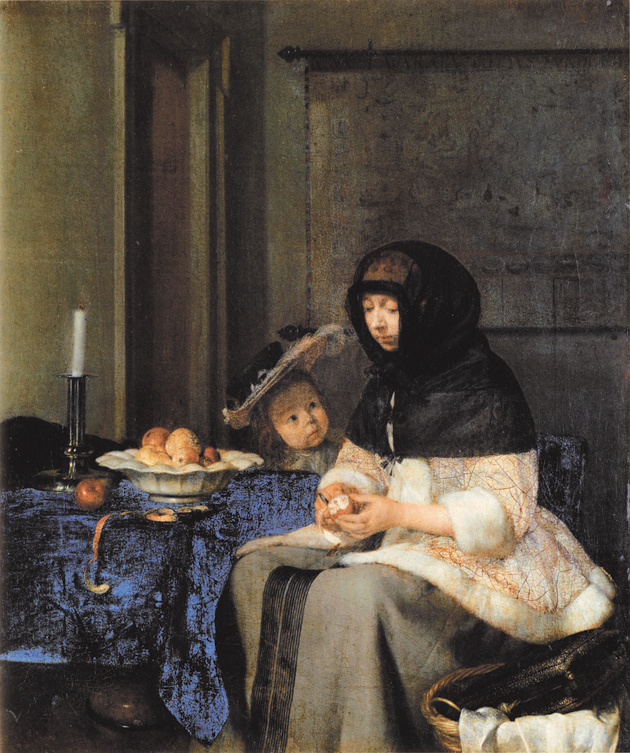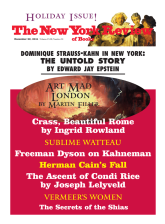The Louvre has lent one of the most revered of seventeenth-century oil paintings, The Lacemaker of Johannes Vermeer, to the Fitzwilliam in Cambridge, one of England’s most distinguished museums; and the Fitzwilliam has organized an exhibition around the loan, presented under the title “Vermeer’s Women: Secrets and Silence.” The thirty-two assembled canvases and panels, all executed in mid-seventeenth-century Holland and all bearing some form of female subject matter, amply justify a detour to Cambridge. They invite you, however, to think about much more in Dutch painting than the art of Vermeer, for only four are actually the work of the so-called “sphinx of Delft,”1 the painter who has over the past century become such a public obsession.
Think what painstaking patience a Mondrian canvas embodies: all that blocking in, pushing brushloads of oils up to the edges of straight lines and neatly squidging the paint into right-angled corners. Walking around this exhibition, you encounter the ancestry of that handiwork. Typically, the framed objects facing you on the wall present systems of interlocking colored compartments. The seventeenth-century Dutch picture-maker—or at least the fifteen now on view—would pass much of his working day filling the rectangle on his easel with smaller rectangles: patches of pigment to denote window and door frames, panes, panels, beams, bricks, and tiles; to describe stiff wooden chairs and tables in the houses thereby assembled; to furnish those houses with further framed rectangles, pictures within pictures.
A canvas by Samuel van Hoogstraten, the largest included—which is not to say much, for it is only forty inches by twenty-eight—has been labeled View of an Interior, but you could read it like one of those 1960s Frank Stellas in which colored stripes head inward concentrically from the canvas edge. What it presents is a doorway giving onto a doorway giving onto a doorway that gives onto a table, a chair, and two half-occluded picture frames. A couple of slippers at a threshold and a couple of figures glimpsed within a frame are minimal sops, teasingly thrown to any viewer who demands that a picture should have a subject.
Van Hoogstraten, a clever and versatile artist—a pupil of Rembrandt’s, the deviser of a doll’s-house “perspective box” now in London’s National Gallery, and the author of a treatise on art—seems to be drily trying out the proposition that he is adding one more right-angled artifact to a world already full of them. A world that is not only right-angled but right-thinking—clean (a waiting broom contributes to the interior’s verticals), well lit, well furnished: a world of recent manufacture, a world that is primly modern. During the 1650s and 1660s, the decades this exhibition considers, the United Provinces were at their apogee of international power, having dominated global shipping and finance since the century’s turn. Their run of economic good fortune spurred on new buildings and new fashions across a network of cities.
The Fitzwilliam’s artists were second-generation beneficiaries of this upgraded civility, working for a picture market that continued to flourish. That scene had moved on from bold, rude pioneers such as Rembrandt and Frans Hals. The new men’s imaginations had been formed by an environment that was at once thoroughly urbanized and fundamentally orderly. Insofar as their art reflected that environment, the canvas had become chessboard-like, and they were looking for ways to refine their game.
What the exhibition concentrates on, therefore, is a range of moves for bringing a queen—a female protagonist—into play. In an assemblage of boxed spaces similar to van Hoogstraten’s, a 1667 canvas by Cornelis Bisschop, such a figure appears sat on a doorstep—a young, modestly dressed housewife, taking a knife to an apple. The S-twist of peel about to fall from the fruit to her lap becomes the composition’s pivot and dynamo. It unites the preoccupied figure and the rooms behind her in a pervasive purposeful hum, so that the ensemble becomes a meditation on self-contained activity, a celebration of quiet inward-turnedness. In fact, intentness is what these painters most often ask their female figures to supply. At base, they give the canvas—the marketable rectangle, this inviting game board—something to be about. The format leads, and the subject follows.
That is to say that, just as Vermeer himself does not exactly hog the limelight in “Vermeer’s Women,” no more do the actual lives of women. Another exhibition might have counterpointed some of the male reveries of compliant femininity shown here—Pieter de Hooch, for instance, ensconcing a sweetly smiling Woman and Child with Serving Maid in a decorous urban dream-home—with a remarkable contemporary quintet of prints by the Amsterdammer Geertruyd Roghman—somber female testimonies on the experience of housework, heavy, unhopeful, and careworn.
Advertisement
But Roghman was a solitary swimmer against the flow. The current that Marjorie Wieseman, the exhibition’s curator, wants to investigate is one of males butting their pictorial imaginations into the women’s quarters. Her essay in the exhibition catalog notes that, owing to a strong if not rigid segregation of spaces, men must often “have felt like strangers in their own home.” Nicolaes Maes, another Rembrandt pupil, led the way in juggling rectangles so as to open up that inner foreignness. His Eavesdropper pans from a townhouse’s streetside business spaces to its deep rear basement, revealed through a door swung open: within that backdrop, a window stands open, and an interloper leans in to canoodle with the housemaid; meanwhile, her mistress hovers on this side of the door, overhearing their sweet talk; but it is only we who see all.
The housemistress smiles at the viewer with a stagey mischief I find jarring. It is as if the picture were congratulating itself on its own ingenuity of contrivance. Maes took from his training with Rembrandt a lovely subtle harmony of tone, but this Eavesdropper’s archness is pitched on the level of Jan Steen, a painter who is famed in Holland for a distinctive line in humor that suffers in export and who here is represented by two faintly risqué scenes of women pulling on and off their stockings. “Ooh, look!” Perhaps that was the bottom line when it came to the Dutch picture market, with its accent on competitive surface appeal: who knows, perhaps it is the bottom line in the whole business of art. The thought, which Steen’s hard-worked efforts tend to induce in me, flattens the soul. But painting’s potential for depth and strangeness gets vindicated by three nearby pictures, accredited to a certain Jacobus Vrel.
There are no documents on the life of this artist. Evidently he never received a standard studio training, for his figure drawing is patently awkward. And yet—and this reflects handsomely on the Dutch picture market and its openmindedness—his naivety was no bar to collectibility, for the Habsburg archduke in Brussels owned pieces of Vrel’s by 1659. The three panels of his in Cambridge show motherly or grandmotherly figures in austerely furnished interiors. These women’s backs are turned. They tug subliminally at your empathy, making you feel how it is to be confined in such a room as the woman inhabits.
In one panel, the woman tilts the chair she is perched on so as to peer through a big window in an otherwise empty white room. Outside, all is black—except that faintly, a child’s face looms up through the night to meet hers, causing her to raise her hand in greeting. The glare within and the dark without clamp the two presences, either side of the glass, in an eerie interdependence—each other’s friend and each other’s spook. It stirs on several levels, this reaching beyond tidy Dutch homeliness to the shock of the unheimlich: not least, it shakes up the history of sensibility a little, winding back Romantic obsessions with windows and averted figures 150 years.
No one else works the rectangular board like that. But I see two main ways you might pitch your game. Some players load the entire rectangle with eye-stopping morsels—Steen and, still more, the assiduous Gerrit Dou with his fine-wrought arrays of luxury goods (rare fabrics, polished silver, delicate damsels, etc). Dou’s faith in the intrinsic value of surface effects is at once mind-numbing and humbling in its sincerity. And then there are those who want to set the board in motion by letting loose some squib of interpersonal dynamics. Preeminently I mean Gerard ter Borch. With five pictures on display, each tonally delicious with its own poise and wit, he is in many ways the star of the show. All probably employ as a model his sister Gesina, herself a quirkily original graphic artist: the ter Borchs were a well-traveled artistic clan who eventually settled in Deventer, about seventy miles east of Amsterdam.
Three of the pictures explore what happens if Gesina poses as a housemistress accompanied by a maid. Is the latter to be her coworker or her underling, and who is really whose fool? In an irresistibly amusing fourth picture she’s with a little daughter, and she’s peeling apples while the girl’s big eyes attempt in vain to burn their way inside her zone of concentration. A fifth reduces Gesina’s opposite number to an opened letter, dangling in one hand while the other raises a glass of wine to her lips: it is the viewer who now has the reading to do, inferring what thought sequence has passed through the lady’s mind.
Advertisement
Behind all these turns toward psychology there may well lie a formal ambition. Can the artist, by laying such clues, ratchet up the viewer’s pace of attention? At the same time, these pictures seem to alter the cultural terrain, opening up possibilities for types of fiction that were yet to be written. A further picture of a reader raising her eyes from the page, painted by Eglon van der Neer in response to Gerard’s example, offers the one point in the exhibition where you could reasonably suppose that an individual woman’s mind was the artist’s chief concern.
How do the paintings by Vermeer fit into all this? Besides The Lacemaker, the Fitzwilliam is displaying the complex and ambitious Music Lesson; also, one Young Woman Seated at a Virginal from London’s National Gallery and a second, very minor, from a private collection. From the company these pictures keep, it readily emerges that Vermeer, who turned twenty in 1652, was a creature of his era with its accent on ingenuity and politesse, and that he was hardly exceptional in his famed devotion to female subjects. Yet at the same time, the singularity of his own artistic refinements is underlined by the comparison.
The Music Lesson, painted around 1662, offers a way into them. A young lady stands at a keyboard with a gentleman to a side attending to her playing: the scenario could easily be ter Borch’s. But are we to read into it, psychologically? Yes, says an overhead mirror that surprises us by revealing how the woman’s gaze is turning toward the man. No, says a swooping perspectival recession that sets them apart from us across a palatial expanse of tiling, placing before our eyes instead a brilliantly palpable jug in the foreground. No again, says the entire surface rendering, which is so precious it would have had Dou gawping, for Vermeer has splurged recklessly on lapis lazuli, turning not only the carpet the jug rests on but the shadows on the far wall into an obsessive, vibrant optical feast. Yes, it is certain that the woman over there has a mind of her own. No, it is certain that it is not ours for the having, for all we can do is look. And looking has its own momentum: if there are any psychological dynamics we can hold onto, they are those of our own visual attention.
One way to express the fascination of The Lacemaker might be that it isolates Vermeer’s two opposed truths and pits one against the other within the smallest possible arena. (The picture is only nine inches by eight.) The homeworker with the lacemaking bobbins could stand for all the women on these walls: she is a quintessence of intentness. In common with most of them, she does not present any specifically erotic appeal, and yet she is the Other, the great fact that the male painter needs to evoke. But all he can ascertain is visual sensations. Vermeer has a mind-boggling technique for transferring these from eye to canvas as if without the hand’s intervention. Color has somehow wafted down, as leaves might on water, and cohered automatically into threads and ringlets and cushions. Or more exactly, into the sight of those objects, set in quotes.
The curators assign the same date—circa 1670—to The Lacemaker as to the Virginal painting from London. But there Vermeer’s balancing act, setting vision and its objects in a precarious philosophic equipoise, flies to pieces. The player and her instrument dissolve into a slither of slick mechanical marks, and no reality can be imputed to her. What life the painting has is abstract—the randomized dancing of the brush as Vermeer simulates the simulated marble of the virginal case. On the scene’s rear wall you might just recognize a rumbustious brothel scene painted by Dirck van Baburen back in 1622, a souvenir of a louder, cruder era: but it has been deconstructed into an assembly of hollow shapes. The whole thing is uncomfortably like an imitation Gerhard Richter.
Michael Taylor, in his recent book Les Mensonges de Vermeer (The Lies of Vermeer), dates the picture two years later, and suggests that if it feels like “sparkling wine gone flat,”2 that may only be partly the fault of the artist. 1672 put not just Vermeer, but much of Holland, out of business: that was the year the French nearly conquered the country; their armies were only stopped by the breaking of the dykes to flood the farmland. Other sectors of the economy might eventually bounce back, but the art market went into permanent decline. Did Vermeer simply abandon his brushes? He died three years later, heavily in debt, at the age of forty-three.
Taylor—also the author of a notable essay on Rembrandt3—sets the precariousness of the artist’s performance on an expanded historical scale. Many quarters of the city that shines so serenely in Vermeer’s famous View of Delft had been annihilated in an arsenal explosion in 1654; even at Holland’s geopolitical zenith, the threat of English or French attack forever lay at hand; while the artist himself, a weaver’s son attempting upward mobility, was never able to free himself from dependence on his rich mother-in-law. Seen in relation to these vulnerabilities, the art with its suave suspension of time looks like a deliberate slamming of the studio door. (Just as it might have been shut on the painter’s large brood of children.) All this complements what Wayne Franits has to say in the exhibition catalog about the internal evidence of social aspiration in the paintings: how the virginals would have been “prohibitively expensive” luxuries, for instance, way beyond Vermeer’s own means. Both Franits and Marjorie Wieseman emphasize that the rooms he so exquisitely furnishes must be treated as imaginative constructs.
What gives Taylor’s account the edge is his poetic exactitude, as deployed for instance on the couple in The Music Lesson:
There is something literally not quite clear about the way he’s staring at the girl. She plays on, ignoring his lack of clarity, while her gaze in the mirror swivels furtively toward the spot where his right hand rests on the end of the spinet. But that is not the point that holds our gaze: it is only a vague shred of meaning in the far reaches of a space whose limits are the softness of the shadows in the mirror and the brightness of the jug in the foreground.4
It’s a picture, Taylor writes, that seeks after “the illusion…of a universe of objects reflecting one another, just as the mind is self-reflexive in its movements.”5 That takes us further than Franits remarking on a “verisimilitude so convincing that the viewer fails to notice some glaring inconsistencies.” “Verisimilitude” has been a standby of Vermeer commentary ever since the critic Théophile Thoré hauled “the sphinx of Delft” out of obscurity in 1866: the implication always seems to be that his paint surfaces resemble photographs. Whether that can still alert us to their mesmeric and slippery reticence, I doubt.
Whether it makes better sense to call Vermeer a liar is another matter. Taylor turns to Oscar Wilde for his book’s epigraph: “Lying, the telling of beautiful untrue things, is the proper aim of Art.”6 But surely the piquancy of that 1890s provocation has evaporated. It may be possible to describe something—some seductive visual effect, for instance—as an illusion without implying any form of moral judgment. But if you call something a lie, you cannot but invoke moral implications. It’s not clear to me on what level you might begin legitimately to rebuke the creator of The Lacemaker or The Music Lesson. “You can’t shut out history,” Taylor alleges, as if Vermeer were standing with his back to a dyke and beyond the flood waters were rising. Oh, but sometimes, and entirely properly, you must: not all our lives can be spent on that plane; occasionally it is necessary that someone, somewhere, should attend to the nature of attention itself.
Dramatically, no doubt, the point is borne out by the evanescence of Vermeer’s imaginative control and the corresponding rise and fall of his family socially. The grandfather of the most refined and fastidious artist of Holland’s “Golden Age”—in fact, its last major original figure—had been an illiterate tailor; when the grandson of the master of the pearls and virginals (always “Johannes” in his signatures, never plain “Jan”) had to witness a power-of-attorney in 1713, he could only make himself known with an X.
-
1
The epithet of the critic Théophile Thoré: to be explained further on. ↩
-
2
“Un vin pétillant éventé“; see Michael Taylor, Les Mensonges de Vermeer (Paris: Biro, 2010), p. 130. Although the author is American, the book has as yet no edition in English. ↩
-
3
Rembrandt’s Nose: Of Flesh and Spirit in the Master’s Portraits (Distributed Art Publishers, 2007). ↩
-
4
“La façon dont il dévisage la jeune fille a quelque chose de pas très clair, au sens littéral du mot. Elle continue à jouer, indifférente à ce manque de clarté, tandis que son regard pivote furtivement vers l’endroit où il pose sa main sur le bord de l’épinette. Mais ce n’est pas là ce que retient l’œil: ce n’est qu’un vague lambeau de signification aux confins d’un espace délimité par la douceur des ombres dans le miroir et l’éclat du pichet au premier plan.” See Taylor, Les Mensonges de Vermeer, p. 102. ↩
-
5
“Vermeer cherche ici non pas a créer une animation illusioniste de gestes corporels, de doigts courant sur un clavier, de regards échangés ou évités, mais celle d’un univers composé d’objets se réfléchissant les uns les autres tel l’esprit se réflétant dans ses mouvements.” See Taylor, Les Mensonges de Vermeer, p. 100. ↩
-
6
Oscar Wilde, “The Decay of Lying,” 1891, cited [in French] on p. 5 of Les Mensonges de Vermeer. ↩






